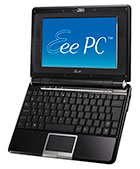 I’ve written about this in the past – the pricing of some netbooks / sub-notebooks and how some of them seemed a bit high. Now we are reaching a point where there is some real competition (from Acer and Lenovo). Last month, we saw a $100 rebate on certain 8.9″ Intel Mobile Celeron-powered Asus Eee PC 900 models. It went on for the full month at several online retailers in the US and it dropped the price below $450 in some cases.
I’ve written about this in the past – the pricing of some netbooks / sub-notebooks and how some of them seemed a bit high. Now we are reaching a point where there is some real competition (from Acer and Lenovo). Last month, we saw a $100 rebate on certain 8.9″ Intel Mobile Celeron-powered Asus Eee PC 900 models. It went on for the full month at several online retailers in the US and it dropped the price below $450 in some cases.
The same $100 rebate (or rather a new one) is currently available on some models at Amazon.com through the end of the month. It’s also showing up for various models of the Asus Eee PC 900 at MWave.com as well as at Buy.com, and OnSale.com
. A quick check of Amazon UK as well as a few other distributors in Europe doesn’t show the rebates (or price drops), but I’m sure we’ll see something in regards to pricing at some point.
With September coming up in less than a few weeks, and with the Acer Aspire One available now (at $379 and $399), and the Lenovo IdeaPad S10 shipping in September for around $430 (and presumably the Dell Inspiron 910), it really makes me wonder when Asus is going to permanently drop the price on these things (as well as drop the prices on their Atom-based lines, along with MSI on the Wind netbooks).
I’m not going to debate the pros and cons of the Intel Mobile Celeron in these things versus the Intel Atoms in the Asus Eee 901 (and the above mentioned Acer and Lenovo models). The average consumer that this market is oriented towards is not going to know the difference or care. I take that back. They’ll hear “1.6GHz Atom versus 900MHz Celeron” or “120GB HDD versus 20GB SSD” and they’ll respond accordingly.
Netbooks were originally meant to be a lot cheaper than some of the ones currently available. Obviously, it’s not a hard and fast rule on these sub-notebooks as far as pricing – but in my opinion it was the low price point that drove the popularity of these things – for years, we’ve had 8.9″ and smaller laptops – Fujitsu’s 1500 and 1600 series, Toshiba’s Libretto U series, Sony’s UX series. The problem is they were prohibitively expensive for many consumers. There was a segment of people that needed small and they were willing to pay a premium for those smaller laptops.
I always suspected that a lot more people would love to have something really small (not too small, but something a physical keyboard that could actually be used to be productive, at least for web browsing, email, etc). I believed this because I’ve had some of the 12″ ThinkPad X-series laptops for years, and people always commented on how small they are (little knowing that there were smaller laptops out there). They were always very interested, but the pricing just wasn’t there.
Now with the pricing for a lot of 8.9″ Atom-powered models hovering around $400, and pricing on 7″ models hovering around $250 – $299, they’ve become affordable for a lot of people.
More importantly, once we get into 2009, you’re going to see a huge market of used netbooks, because these are cheap enough, that when some fancy new model comes out for $400, many people will be willing to sell their old models for $200 on e-bay or wherever and buying the new one. In fact we’ve already seen this with some selling their Celeron-based netbooks for the Atom-based netbooks.
Think about it – these things are dropping down to the prices of high-end cell phones, and a lot of people would have no problem upgrading such devices nearly every year. This probably scares some manufacturers, but netbooks will probably even have an impact on “budget” lines.
Even Intel acknowledged at the Intel Developer Forum this week that these have the potential to cannibalize some laptop lines, but at the same time Intel sees these as allowing them into markets that were previously untouched (and obviously Acer and Lenovo and Dell see it as well).
In some cases, netbooks maybe the first laptops that some families own – before now they may have had desktop machines. These are very attractive, and as the performance goes up, I could see many buying these for their children.
Acer, Lenovo and possibly Dell show every intention of keeping the price low on their models. When you combine the price of flash memory dropping substantially and the competition, at some point Asus is going to have to permanently drop the price on some of these lines. MSI will have to follow suit as well with the 10″ Wind U100.
If anything, the used/resell market will force them to.

http://bits.blogs.nytimes.com/2008/08/22/netbook-prices-are-now-falling/
NY Times is talking about this price drops to.